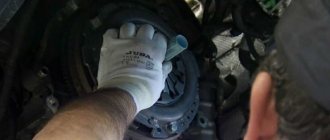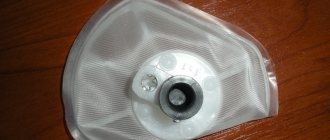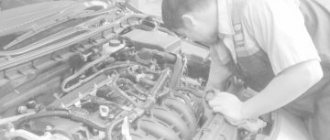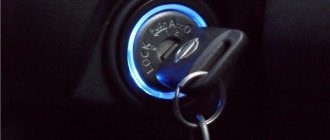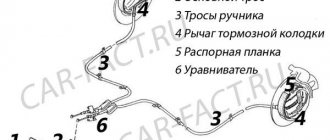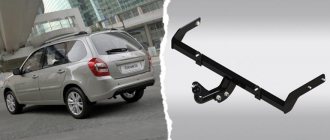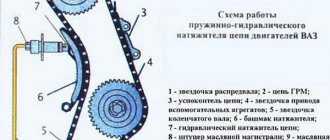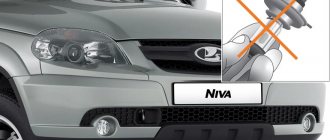Operating rules
In order to avoid new clutch problems, you should follow these simple rules:
- Press the clutch pedal smoothly, but release it more sharply, but without throwing it.
- When parking on an incline, it is better to release the clutch pedal and engage the handbrake (handbrake - approx.). The handbrake must be adjusted and keep the machine on the slope.
- Shift gears as quickly as possible, avoiding “throwing” of the gearbox.
- In the cold season, when many people press the clutch pedal to make it easier to start the engine, the clutch experiences increased load. The clutch system does not suffer wear only when the oil warms up.
- While driving, do not keep your foot on the clutch pedal, but slightly further away from it.
As you can see for yourself, despite the fact that the process of replacing the clutch is quite complex, time-consuming and will take more than one or two hours of your time, it is still possible to do it yourself.
Reference!
Clutch - thanks to this mechanism, torque is transmitted from the transmission to the engine. The transmission itself is carried out thanks to the presence of a clutch cable, which connects the mechanism to the gearbox, due to which the start, braking and gear shifting take place.
Nuances when choosing spare parts for a torque transmission unit
You should consider the range of parts on the market based on your own needs and driving style. Experienced owners recommend:
- immediately change the slave and master disks;
- pay attention to kits only from leading manufacturers: Kraft-Tech, Sachs, Valeo, LUK, VIS;
- in case of increasing the power of the internal combustion engine, use a driven disk with friction linings made of composite and ceramic materials.
When purchasing a product, you should pay attention to the absence of cracks and burrs, the uniform thickness of the disks, as well as the service life of the assembly unit. The latter directly depends on driving style and can range from 10,000 to 150,000 km.
What malfunctions can happen to the clutch?
Although this list is small, if problems arise it can cause quite a few problems:
- The clutch does not engage - this malfunction occurs when the clutch pedal has too much free play. As a rule, when engaging first gear, a characteristic cracking sound occurs from the gearbox. This problem should not be ignored, as it can lead to even greater problems with the gearbox itself.
- Clutch slipping - the cause of this malfunction is that the car does not gain the required speed when the engine speed increases. As a rule, this is observed first at high speeds, but then becomes noticeable at the “bottoms”. The second symptom is an unpleasant odor that appears at high engine speeds. If such a problem is observed, it is necessary to urgently diagnose the clutch.
- Incorrect travel of the clutch pedal is a sign of this breakdown, uneven travel of the clutch pedal, when the pedal at one time returns to its original position, and at another it is in free floating. It would seem that the reason lies in the spring, but the inspection should begin with the clutch cable.
- The car jerks when you press the clutch pedal - this malfunction is very serious and you should urgently check all connections and the entire clutch for wear and notice them.
Where and from whom to buy?
A driver who is planning to buy a new clutch for a Lada Kalina car has a question about where it is better to purchase such a mechanism. In total, the car owner has three options:
- Car market.
- Online store.
- Special shop.
It is important to contact reliable distributors. The characteristics of such companies are the following:
- Long-term operation on the market.
- Availability of licenses and certificates.
- Issuance of a warranty card.
- Good customer reviews.
How to check the release bearing on Kalina and how malfunctions manifest themselves (noisy or buzzing)
To understand whether your Kalina needs to replace the clutch, you must first respond in time to signs of failure and diagnose the unit. Signs of a malfunctioning Kalina release bearing:
- Noise or hum when pressing the pedal (damaged, insufficient lubrication or jammed);
- Difficulty pressing the pedal occurs when the coupling ear is broken, as well as the spring is deformed;
- These videos clearly show when the Kalina release bearing is faulty (noise, buzzing, knocking, creaking), as well as how to check the release bearing.
Example of noise during a fault:
Clutch noise when pressed:
The VP fell apart - sounds:
How to check the release lever without removing the gearbox:
What happens if the VP jams:
Clutch problems and solutions:
How to remove the release bearing from a Lada Kalina - location of the part and gearbox mounting diagram
As mentioned at the beginning of the article, to correctly replace the VP and dismantle it, you will need to remove the gearbox. Below is a photo of the transmission from below. To dismantle the manual transmission, you will need to disconnect all the components under the hood that are attached to it. Next, the wheel drives and front suspension elements are removed. Then the manual transmission is unscrewed from the “engine” and removed. Inside the “head” of the clutch housing is the release bearing itself.
The structure of the manual transmission-2181 and the location of the release bearing in the cable box
Description of design
Clutch Surely, while in a driving school, everyone took a course on the design of transmission components, but it’s unlikely that everyone went into all the details and, I must say, in vain. Knowledge of the design and principles of operation will allow the owner to identify a breakdown at an early stage, take measures to eliminate it and avoid large costs for major repairs. Therefore, let’s briefly consider the components of the clutch of a Lada Kalina car:
- casing;
- release bearing;
- pressure disk;
- driven disk;
- drive cable;
- fork lever;
- cable length adjustment mechanism.
The type of friction clutch used on this model is single disc, dry with a diaphragm type spring. The aluminum casing is integral with the gearbox. Modifications involve the installation of two types of transmission components - with a diameter of 190 and 200 mm. You can determine which one is used in a particular car by the number of starter mounting bolts: two – 200 mm and, if there are three bolts, then – 190 mm.
The clutch housing is secured to the flywheel with six screws. Three pins on the flywheel fit into corresponding holes in the housing, thereby centering it. As the linings wear out, the cable length changes automatically and does not require intervention from the owner.
Methods for checking the technical condition of a friction clutch
When the pedal is released, torque should be transmitted from the motor to the transmission without loss. Smooth inclusion and absence of jerking indicates normal operation of the unit. Before replacing a faulty clutch on Kalina, you should perform the following measures:
- Check the clutch pedal travel.
- Press the pedal and make sure there are no jams or extraneous noises.
- Measure the distance from the floor to the outer surface of the pedal (factory size – 146 mm).
- Check gear engagement with the engine running.
- Check for smooth operation, absence of slipping and burning smell.
The presence of any of the following deficiencies may indicate a malfunction:
- release bearing;
- drive cable;
- pressure plate;
- driven disk.
When troubleshooting breakdowns, experienced motorists advise changing all parts at the same time. Even if, say, the problem was in the driven disk, then it would be correct to install a new basket and release bearing at the same time, and not wait for the next breakdown and disassemble the assembly again.
We choose what we will put on the replacement car
On the Lada Kalina, the manufacturer can install one of two types of clutch: with a diameter of 190 mm and 200 mm. It is easy to calculate which type is installed on your car: we count the bolts that secure the starter: 2 - 200 mm, 3 - 190 mm. Which kit to purchase depends on your desire and financial capabilities.
This may be the official supplier of the manufacturer’s conveyor, or there may be companies specializing in the production of similar products. It is believed that imported ones work more softly - these are Valeo and Sachs. How long it takes, as stated above, depends on the operation of the car. An average clutch kit lasts up to 100,000 km.
What will tell you about the need for repairs?
Each car has its own “diseases”. A common problem with the Lada Kalina car is that the clutch system does not always work correctly over time. True, this disease is not chronic and is quite rare. In most cases, this is due to the release bearing or indicates that the clutch disc needs to be replaced. If we consider the top faults of the Lada Kalina, then this one confidently takes 8th position.
It is not recommended to replace the disc and bearing separately; they can only be replaced as an assembly. In order not to remove the gearbox every time, it is highly advisable to change the clutch in one set. Before making a decision about the need to replace the clutch kit, let’s figure out what characteristic malfunctions appear and whether it is possible to carry out adjustments, thereby postponing expensive repairs for some time.
The machine itself will “tell” and “show” that problems have arisen in the operation of the mechanism. The main thing is not to miss the moment and make do with minor repairs or adjustment of the clutch cable, without waiting for the fault to manifest itself on the track and the repairs will cost a lot of money.
Before solving the problem of replacing the clutch, let's consider what can be done in terms of adjustments.
Lada Kalina cars are equipped with a single-plate dry clutch with a central spring and connected to the pedal via a clutch cable, which are self-adjusting via a ratchet mechanism.
Malfunctions when the cable needs to be replaced or adjusted:
- the clutch pedal clicks;
- the pedal sticks;
- its stroke is increased;
- the clutch “led”, and only an autopsy will reveal the answer;
- speeds turn on, but with problems;
- it may slip;
- you can smell something burning in the cabin;
- strong vibration;
- Speeds don't turn on at all.
In any case, there may be more problems, and the clutch disc will need to be replaced, and with it the entire set. You'll have to dig deeper into the belly of your iron friend.
Replacing the release bearing Kalina 2, 1118, Cross, Sport
To make a replacement you will need to put your car on a pit or a lift. Repairs are also possible if you have reliable supports and a jack. It is worth noting that without a pit or lift, the replacement method without removing the box, which is described at the end of the article, is suitable.
Important to know: For work, it is best to use a set of sockets with a ratchet. When directly dismantling the manual transmission, ask someone to help you “pull” it off. To replace the VP without removing the box, you will need two studs with a diameter of 10 mm and a length of 30-35 mm.
How to remove the gearbox and release bearing on Kalina 2 (1.4-1.6 8kl) with your own hands
Replacing the release bearing on a Lada Kalina begins with dismantling the gearbox; this process is described in detail in step-by-step instructions with photos/videos. Perform the operations in order.
- Open the hood of the car and immediately remove the battery.
- Next, remove the air filter by unscrewing the clamp and disconnecting the fastenings to the body.
- The clutch cable is located behind the battery; you need to unscrew the nut and disconnect the cable from the fastener.
- Now disconnect the plug of the speed sensor wire, it is located behind the “engine”, in the area of the pipes.
- Next, find the upper bolts securing the gearbox to the engine and unscrew them.
- The last operations on top of the gearbox are unscrewing the starter and its terminals, as well as disconnecting the clutch cable and electrical wiring.
- Remove the front wheels and tighten the hub nuts. We disconnect the protection (mud flaps) under the wing.
- Immediately disconnect the terminal of the reversing lights wire.
- Nearby there is a suspension beam, first twist the rear nut with a 24mm wrench.
- Now we move on to the ball joints, loosen the nuts and remove them on both sides.
- On the same side of the manual transmission we find the oil drain plug, unscrew it and drain it into any container.
- Between the manual transmission and the engine there is a clutch protective cover. To remove it, unscrew the nuts around the perimeter.
- Let's move on to dismantling the gearshift mechanism. First, unscrew the two bolts and remove the cover.
- Then unscrew the screw that secures the linkage connection.
- The next step is to remove the wheel drive shafts from the gearbox on both sides.

